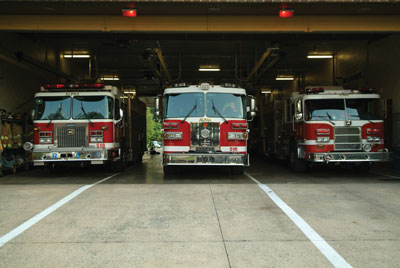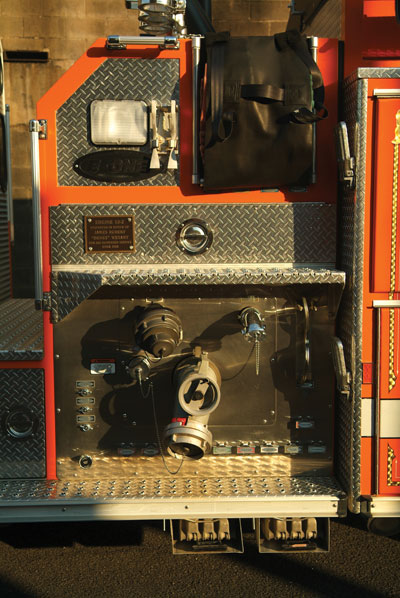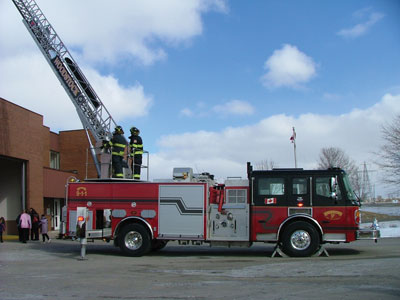
Features
Training
Back to Basics: February 2012
Fire apparatuses are basic tools of the fire service. Every fire department relies on apparatuses to help them do their jobs.
February 13, 2012
By Mark van der Feyst
Fire apparatuses are basic tools of the fire service. Every fire department relies on apparatuses to help them do their jobs. Apparatuses have been part of the fire service since day one, when horse-drawn carriages were used to transport firefighters and water. Today’s apparatuses, whether custom-built or factory models, are highly technical pieces of equipment.
 |
|
| Photo 1: Three types of fire apparatuses: engine 510, truck 516 and rescue 518. All three look the same, but have different configurations and tools and are used for different operations. Photos by Mike Gutschon
|
In the fire hall, it is our job to routinely check the trucks. In volunteer departments, this may happen on a weekly, bi-weekly or monthly schedule. In career departments, truck checks are done daily. Safety is the main reason for conducting apparatus checks. Conducting a daily, weekly or monthly check ensures that the trucks are safe and ready for service. In Ontario, the Ministry of Transportation requires that all commercial trucks be checked at the beginning of the day and at the end of the day. The fire service uses truck check sheets to record these safety checks. These sheets show the ministry that the apparatus has been checked for safety and is ready for service. Many fire departments do not document conducted truck checks. It is very important for the fire department and for the public we serve that truck checks are documented.
In the beginning, the fire service had just one type of apparatus – the horse-pulled, manual or steam-driven pump. Today, there are several types of apparatuses, such as engines, rescues, ladder trucks, quints, mini rescues, brush trucks, foam trucks, air and light trucks, command vehicles, rescue engines and tankers. Fire departments can build trucks that suit their needs. Most trucks look the same from the front but differ in the kinds of tools they carry, the operations for which they are required, and the frequency with which they are used.
There are four areas to be addressed when checking any type of truck: the outside, the inside, the operations and the equipment.
■ Outside
To check the outside of the truck, the truck needs to be running, with certain apparatus functions operating. The entire truck can be inspected by conducting a 360-degree walk around. Inspecting the outside of the truck includes areas such as:
- General appearance – does the truck have any damage on the body, any scrapes?
- Windows – check all windows for cracks and chips. Are the windows clean, are the mirrors attached securely, and are the wiper blades in good condition?
- Tires – are the tires inflated to the proper pressure? Is tread depth above par? What is the condition of the tires? Are the lug nuts secure and not loose? Are there any rocks in between the back dual tires?
- Lights – are the headlights working? What about the high beams, hazard lights, and emergency lights? Are any bulbs out? Are any lenses damaged? Are the turn signal indictors, running lights and pump panel lights working?
- Air brakes systems – drain the air tank reservoirs. Are there any air leaks?
- Compartment doors – do they open and close properly?
- Equipment – make sure that any equipment attached to the truck on the outside is secure and not ready to fall off.
- License plate – ensure that the current sticker is on the plate. Ensure both plates are on the truck if two are required and that the commercial inspection sticker is present and current.
■ Inside
The inside of the truck needs to be checked for proper operation. Drivers need to ensure that the truck is ready to drive. The driver will need to adjust the driver’s seat for proper distance and height, adjust the mirrors (on some trucks), and adjust the telescoping steering wheel. Other aspects of the inside include:
- Gauges – check all gauges on the driver dashboard: fuel, air gauges, oil temperature and transmission oil pressure gauge.
- Switches – ensure all switches and signals are working.
- Lights – ensure all interior lights work.
- Sirens – ensure that the siren functions work, along with the air horn.
- Air brakes – conduct air brake test to ensure that all safety features of the system are working.
- Engine – check all fluids are topped up, such as oil, transmission fluid, power steering fluid, windshield washer fluid, radiator levels, hydraulic fluid and brake fluid. Check belts for wear and tear, battery terminals for corrosion and hoses for cracks
■ Operations
Operations vary depending on the types of apparatuses to be checked. In a rescue truck or certain ladder trucks, there may not be a pump to operate. Other trucks have special operations, such as air-cascade systems. On most trucks, checking the operations involves operating the pump. Newer trucks have an electronic governor system; older trucks have a pump bypass valve. The pump bypass valve can be tested to ensure that it works, whereas the electronic governor cannot be tested.

|
|
| Photo 2: Check the pump panel, intakes and discharge ports. Wheel chocks need to be accounted for.
|
The pump bypass valve can be set once the pump is operating. If the pump runs at 500 psi and the bypass valve is set, the throttle can be increased to raise the pump discharge to 600 psi and test it. The pump bypass valve should dump the excess pressure right away to maintain 500 psi. If this happens, then the valve works. If it does not happen, there may be a problem. It is necessary to ensure that all features of the pump are working, including the pump heater, the cooling function, drains for each discharge and intake port, the foam system (if so equipped) and the primer. The primer should be operated for about 10 seconds to ensure that it works and to get the air out of the pump.
When checking aerial devices, the ladder, outriggers and devices attached to the ladder need to be operated. Each aerial truck has different setup procedures. It’s important to follow the manufacturer’s procedures. There are safety systems built into aerial devices that allow one function to be operated at a time. If the aerial is not set up properly, certain functions will be prohibited. For example, there is a limiter switch on the outriggers that tells whether they are fully extended. If they are, the aerial device will operate fully. If the outriggers are not fully extended, the limiter switch will prohibit certain operations.

|
|
| Photo 3: Quints have an option that allows the nozzle to be in a rescue- or water-flow position. A locking pin is used to hold the nozzle assembly in either mode. While checking the truck, make sure the pin is secure in either position.Photo by Mark van der Feyst |
The aerial – whether a straight stick or a platform – needs to be fully extended and rotated 360 degrees.
It is a good idea to fully extend the ladder and have it at zero degrees to one side. This allows you to walk underneath the aerial to inspect the water pipe, the sheave wheels, the cables and the grease on the ladder rails. You should operate the nozzles, any communicating devices and auxiliary outlets. Once these areas are checked, the aerial device can be bedded.
All scene lights should be operated using the on-board generator. Many rescues, engines and ladder trucks have these items. Rescues also have other items, such as winch systems, that need to be operated.
■ Equipment
When checking the truck, you will need to operate all mechanical equipment, such as chainsaws, circular saws, positive pressure fans, hydraulic auto-extrication tools and thermal cameras. Other equipment on the truck, such as hand tools, the medical bag, the defibrillator, SCBA bottles, nozzles and hose, also need to be checked.
Checking the outside, inside, operations and equipment of your apparatuses ensures that they are ready for service and familiarizes firefighters with the trucks and the equipment they carry. Too many firefighters and officers are not familiar with the equipment on their apparatuses. Going back to basics helps us train to be proficient with our trucks.
Mark van der Feyst is a 12-year veteran of the fire service. He currently works for the City of Woodstock Fire Department in Ontario. Mark is an international instructor teaching in Canada, the United States and India. He is a local-level suppression instructor for the Pennsylvania State Fire Academy, an instructor for the Justice Institute of British Columbia and a professor of fire science at Lambton College. E-mail him at Mark@FireStarTraining.com
Print this page